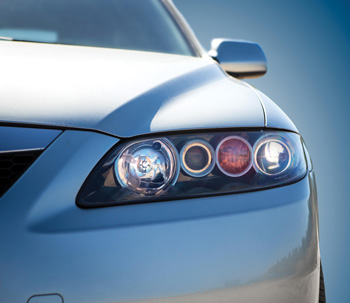 Replacing headlamps and tail lamps is inevitable as a vehicle ages. The average life of an original equipment halogen headlamp may range anywhere from 500 up to 1,000 hours, or about 3 to 4 years of average driving. The life of the headlamps depends on usage, so if a motorist does a lot of nighttime driving their headlamps won’t last as long as those on a vehicle that is driven mostly during daylight hours. Also, if a vehicle is equipped with Daytime Running Lights, it will reduce bulb life even more (even though DRLs typically run at reduced voltage).
Replacing headlamps and tail lamps is inevitable as a vehicle ages. The average life of an original equipment halogen headlamp may range anywhere from 500 up to 1,000 hours, or about 3 to 4 years of average driving. The life of the headlamps depends on usage, so if a motorist does a lot of nighttime driving their headlamps won’t last as long as those on a vehicle that is driven mostly during daylight hours. Also, if a vehicle is equipped with Daytime Running Lights, it will reduce bulb life even more (even though DRLs typically run at reduced voltage).
An upgrade option for motorists who do a lot of nighttime driving or applications where replacing the headlamps is difficult would be “long life” replacement bulbs. Many claim to last 2 times to 4 times as long as standard halogen headlamps.
Incandescent bulbs (all types) eventually fail because heat and vibration cause the tungsten filament inside the bulb to burn out or break. Over-voltages also can hasten the demise of incandescent bulbs. Bulb are designed to operate at a specific voltage, and if there’s only a few tenths of a volt more than normal, it will reduce bulb life significantly. So, if a vehicle has a history of burning out headlamps or other bulbs rather quickly, the lighting circuit may be getting too much voltage.
Many late-model vehicles can sense a bulb failure and will illuminate a “Lamp Out” indicator light to alert the driver a headlamp or taillight is not working. Other things can cause good bulbs to stop working, like wiring and lighting module faults, or corrosion in a bulb socket.
High Intensity Discharge (HID) headlights (the kind that give off a bluish-colored light) are brighter (2 times to 3 times more lumens per watt) and longer-lived (2 times to 5 times longer or 2,000 to 4,000 hours) than regular headlamps. But they are also more expensive to replace. True HID systems use high voltage (up to 23,000 volts!) Xenon-filled bulbs that have no filament. The high voltage creates an electrical arc inside a quartz tube to create a bright, white light (near 4,200 degrees K, which is close to natural daylight). The light produced by HID Xenon headlamps is about 14 percent ultraviolet, which is filtered but still gives the headlamps a slightly bluish cast.
HID bulbs run HOT (up to 1,500 degrees F) and contain up to 30 atmospheres of internal pressure. This creates a potential burn and explosion hazard, so do not attempt to power a HID bulb outside of a headlamp assembly to “test” it. Also, the HID bulb must be in a horizontal position when it is on, otherwise it may overheat and fail.
One way to tell if a vehicle is equipped with HID headlamps is to look at the outer lens cover. If the headlamps are HID, the markings D1R, D1S, D2R or D2S will usually be marked on the lens cover.
Replacement headlamp bulbs that simulate the color and intensity of HID headlights are available to upgrade lighting performance and illumination. Some bulbs have a tinted outer coating to achieve the HID look while others use a different mix of gases inside the bulb (including Xenon) to change the color and intensity of the bulb. However, many of these high-performance headlamps have a shorter service life (maybe only 150 to 320 hours). Consequently, they have to be replaced more often than standard halogen headlamps.
Also, if one headlamp has burned out, recommend replacing both headlamps at the same time because if one has failed, the other will likely fail soon, too.
Light Emitting Diodes (LEDs) are replacing conventional bulbs in the tail lights, stoplights and turn signals of many late-model vehicles, and even some headlights. Most of the frontal LEDs to date are for styling and/or Daytime Running Lights rather than actual illumination, but that will change as this technology continues to advance. LEDs are very long-lived (more than 10,000 hours) and use less wattage than incandescent headlights. Retrofit LED bulbs are available to replace many conventional bulbs, but cost more than standard bulbs. The payback is their longevity.








